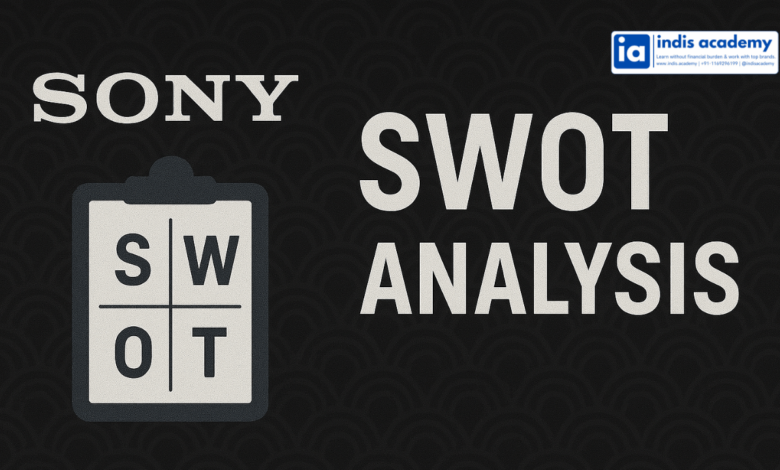Sony SWOT Analysis: Key Business Strategies & Market Challenges

Sony isn’t just about PlayStation or TVs — it’s a global innovation giant that has shaped entertainment, technology, and creativity for decades.
From producing blockbuster movies to dominating the gaming world, Sony continues to be a household name across the globe.
But what keeps a brand like Sony relevant in today’s ever-changing market? That’s where strategic analysis comes into play.
Understanding a company’s internal strengths and weaknesses, along with external opportunities and threats, is crucial for sustainable growth — and that’s exactly what a SWOT analysis helps us do.
In this article, we’ll dive deep into the SWOT Analysis of Sony Corporation, examining its core strengths, potential challenges, future opportunities, and rising market threats.
We’ll also explore the key strategies Sony is using to stay ahead in highly competitive industries like gaming, entertainment, and electronics.
Ready to uncover the business engine behind this iconic brand? Let’s get started.
Learn AI & Digital Marketing,
Pay Fees After Placement
- ✅ Minimal Admission Fees
- ✅ No Loan or Income Sharing Agreement
- ✅ 100% Placement Support
- ✅ ISO & Govt Registered Certificate
- ✅ Practical 3+1 Months Duration
Get a free counseling call. We’ll guide you through learning, certification, and job placement.
Request a Free Call Back
Takes less than a minute.
Overview of Sony Corporation
Founded in 1946 in Tokyo, Japan, Sony Corporation has grown into one of the world’s leading multinational conglomerates. With operations in more than 190 countries, Sony is a dominant force in electronics, gaming, entertainment, and financial services.
The company is best known for its PlayStation gaming consoles, Sony Pictures, Sony Music, and a wide range of high-quality consumer electronics. In FY2023, Sony reported revenue of over $85 billion, driven by strong growth in gaming and entertainment segments.
Sony consistently ranks among the top global tech and media companies, thanks to its innovation-first approach and diversified business model.
🔗 Want to know more? Check out our article on the History of Sony and Sony’s Marketing Strategy.
Sony’s Major Global Competitors
| Company | Country | Key Segment Competing with Sony | Notable Products/Brands |
|---|---|---|---|
| Samsung | South Korea | Consumer Electronics, TVs | Galaxy, QLED TVs |
| Microsoft | USA | Gaming (Xbox vs PlayStation) | Xbox Series X/S, Game Pass |
| Apple | USA | Consumer Electronics, Entertainment | iPhones, Apple TV+ |
| LG | South Korea | Electronics, Home Appliances | OLED TVs, Smart Devices |
| Nintendo | Japan | Gaming | Nintendo Switch, Games |
| Amazon | USA | Entertainment (Streaming), Cloud Gaming | Prime Video, Luna |
| Panasonic | Japan | Electronics, Imaging Technology | Lumix Cameras, Home Devices |
What is SWOT Analysis?
A SWOT analysis is a strategic planning tool used to evaluate a company’s internal and external factors that can impact its performance and future growth. The term SWOT stands for:
- S – Strengths: Internal capabilities that give the company an edge
- W – Weaknesses: Internal limitations that hinder progress
- O – Opportunities: External factors the company can capitalize on
- T – Threats: External risks that may challenge growth
For a global brand like Sony, conducting a SWOT analysis helps uncover what it’s doing right, where it’s lagging, and how it can adapt to a constantly evolving market.
Whether you’re a business analyst, student, or just curious about Sony’s strategies, understanding its SWOT analysis offers a crystal-clear snapshot of how the company maintains its competitive position in industries like gaming, electronics, and entertainment.
Stay with us as we break down Sony’s strengths, weaknesses, opportunities, and threats in the next sections.
Sony’s Strengths
Sony’s long-standing global presence and innovation-focused mindset have earned it a powerful competitive edge. Here are the key strengths that make Sony a market leader:
1. Strong Brand Value and Global Recognition
Sony is a household name with a trusted reputation built over decades. Ranked among the world’s most valuable brands, it enjoys high customer loyalty across electronics, gaming, and entertainment sectors.
2. Market Leadership in Gaming (PlayStation)
With over 117 million PlayStation 4 units and strong early sales of PlayStation 5, Sony dominates the gaming console market. Its PlayStation Network also offers a robust digital ecosystem that attracts millions of active users.
3. Diversified Business Portfolio
Sony operates successfully across multiple industries—consumer electronics, gaming, music, movies, and financial services—which reduces dependency on any single market and ensures steady revenue streams.
4. High Investment in R&D and Innovation
Sony is known for pushing technological boundaries. From mirrorless cameras and smart TVs to next-gen gaming consoles and AI-powered devices, innovation is central to its growth strategy.
5. Strong Presence in Entertainment
Sony Pictures and Sony Music are global giants in the entertainment world. With popular franchises like Spider-Man and collaborations with top artists like Beyoncé and Adele, Sony holds strong intellectual property rights that continue to generate recurring revenue.
Sony’s Weaknesses
Despite being a global powerhouse, Sony isn’t without its challenges. These internal limitations can affect its ability to grow and compete across all markets.
1. Overdependence on PlayStation Segment
While the PlayStation brand is a major revenue driver, Sony relies heavily on its gaming division. Any disruption in this space—like chip shortages or increased competition—can significantly impact overall performance.
2. Declining Performance in Mobile and TV Segments
Sony has struggled to keep up in the smartphone and television markets, where competitors like Samsung, Apple, and Xiaomi have a stronger hold. Its Xperia phones, for example, lag behind in both innovation and sales volume.
3. Premium Pricing Strategy
Sony products are often priced higher than competitors. While this maintains brand value, it also limits market penetration in price-sensitive regions like South Asia and Africa.
4. Complex Organizational Structure
With operations spread across multiple industries and geographies, Sony’s structure can be slow in decision-making and adapting to market shifts—especially when compared to more agile startups or focused tech giants.
5. Limited Focus on Emerging Markets
Sony has yet to fully capitalize on the fast-growing demand in emerging economies. In countries like India and Brazil, local brands and budget-friendly competitors have taken a stronger lead.
While none of these weaknesses are deal-breakers, they do present areas where Sony must evolve to remain competitive in a fast-paced global market.
Sony’s Opportunities
Sony operates in industries that are evolving rapidly, and with the right strategies, it can tap into several high-growth areas. Let’s explore the key opportunities that can shape Sony’s future.
1. Expansion in AI, Robotics, and IoT
Sony has already started investing in AI and robotics, and its sensor technology gives it an edge in smart devices and automation. As the demand for smart homes and connected devices grows, this could become a major revenue stream.
2. Growth in the Gaming and Metaverse Ecosystem
The gaming industry is booming, and Sony’s early experiments in VR (PlayStation VR2) position it well for future metaverse integration. Expanding cloud gaming and immersive content can take its PlayStation brand to new heights.
3. Rising Demand for Digital Entertainment
With the success of Sony Pictures and Sony Music, the brand can further expand its digital presence through streaming platforms, original content, and partnerships with OTT giants. Think Netflix, Amazon Prime, and SonyLIV collaborations.
4. Strategic Acquisitions and Collaborations
Sony has the financial strength to acquire or collaborate with emerging tech and media startups. These strategic mergers and alliances can help Sony stay relevant in competitive markets.
5. Sustainability and Green Technology Trends
As consumers lean towards eco-conscious brands, Sony’s commitment to sustainable innovation and green products can open doors to new customer segments and improve brand equity.
By leveraging these opportunities, Sony can further strengthen its global presence and remain a forward-thinking brand across all major industries.
Sony’s Threats
Even global giants like Sony face external challenges that can disrupt operations and growth. Here are the key threats Sony must navigate in today’s volatile business environment:
1. Intense Global Competition
Sony operates in highly competitive industries—electronics, gaming, entertainment—where rivals like Samsung, Microsoft, Apple, and Amazon are constantly innovating. Falling behind in tech or pricing could mean losing market share.
2. Rapid Technological Change
Technology is evolving faster than ever. If Sony fails to adapt to new trends—like cloud gaming, AI, or immersive tech—it risks becoming outdated in key product segments.
3. Supply Chain Disruptions
Global events such as pandemics, wars, and chip shortages have shown how vulnerable supply chains can be. Delayed product launches and increased costs due to sourcing issues can severely affect profitability.
4. Cybersecurity and Data Privacy Risks
With digital services like PlayStation Network and online streaming, Sony faces constant threats from data breaches, cyberattacks, and user privacy violations—any of which can damage its brand trust and invite legal scrutiny.
5. Economic and Geopolitical Instability
Trade restrictions, currency fluctuations, and geopolitical tensions in key markets (like China and the U.S.) can hinder operations, limit expansion, and impact revenue from international sales.
By staying alert to these external threats and building agile, tech-forward responses, Sony can continue to defend its market position while exploring new growth paths.
Key Business Strategies of Sony
To stay relevant in a dynamic global market, Sony follows a mix of innovation-driven, customer-centric, and diversification-based strategies. These business moves allow the company to lead in technology, gaming, and entertainment while adapting to global challenges.
1. Innovation-First Approach Through R&D
Sony invests heavily in research and development, allocating billions annually to push the boundaries in imaging sensors, gaming tech, audio systems, and AI integration. This focus helps Sony maintain product superiority and future-proof its offerings.
2. Strengthening Digital Ecosystems
With platforms like PlayStation Network, SonyLIV, and Music Unlimited, Sony is building digital ecosystems that combine content, subscription models, and user communities—driving recurring revenue and long-term engagement.
3. Diversified Business Portfolio to Mitigate Risks
Sony has strategically spread its business across five core sectors: electronics, gaming, entertainment, imaging, and financial services. This diversification reduces dependency on any one sector and keeps the company resilient during market disruptions.
4. Strategic Partnerships and Acquisitions
Sony frequently partners with game developers, production studios, and tech startups to expand its reach. Notable examples include acquiring Bungie (game developer) and collaborating with Marvel for blockbuster movie franchises.
5. Sustainability and Green Innovation Goals
Sony aims to become carbon-neutral across its entire value chain by 2040. Through eco-friendly packaging, energy-efficient products, and sustainable sourcing, it’s aligning with global environmental expectations—while enhancing brand reputation.
These strategies ensure that Sony doesn’t just survive—it thrives by staying ahead of the curve, expanding into future markets, and delivering exceptional user experiences across its ecosystem.
Market Challenges Sony Faces Today
While Sony continues to innovate and lead in multiple industries, the road ahead isn’t without bumps. Here are some real-world market challenges that Sony is actively dealing with in 2025:
1. Supply Chain Volatility Post-Pandemic
Even in 2025, global supply chains haven’t fully stabilized. Shortages of critical components—especially semiconductors—are delaying product rollouts and increasing manufacturing costs, affecting segments like PlayStation and high-end electronics.
2. Shrinking Demand in Traditional Consumer Electronics
As markets for TVs, cameras, and home audio mature, Sony faces slowing demand and tighter margins. With more affordable alternatives flooding the market, premium pricing has become a challenge in price-sensitive regions.
3. Cloud Gaming Competition and Platform Wars
While Sony leads in console gaming, it’s now in a fierce race with Microsoft (Xbox Game Pass), Google (Stadia, now shut down), and NVIDIA for dominance in cloud-based gaming—a space that demands faster infrastructure and deeper integration with digital ecosystems.
4. Balancing Legacy Hardware with Digital Growth
Sony’s shift toward a digital-first model is slowed down by its legacy hardware products and physical retail dependencies. Balancing both worlds while ensuring profitability is a strategic tightrope.
5. Evolving Consumer Preferences
Today’s users expect personalized, seamless, cross-device experiences—and if Sony doesn’t match the speed of expectations set by Apple, Netflix, or Amazon, it risks losing mindshare among younger audiences.
Sony’s ability to recognize and respond to these ongoing market challenges will determine how successfully it can navigate the future and maintain its leadership across industries.
Conclusion & Final Thoughts
Sony has proven itself as a resilient and innovative leader across several industries, from gaming to entertainment to electronics.
By leveraging its strong brand value, diversified portfolio, and constant investment in research and development, the company has positioned itself for long-term growth.
However, it faces internal challenges like overdependence on PlayStation and external threats such as intense competition and supply chain disruptions.
Despite these challenges, the company is strategically tapping into new opportunities in AI, cloud gaming, and sustainable tech to ensure its future relevance.
Sony’s commitment to innovation, diversified business ventures, and green initiatives are key drivers that will help it stay competitive in an increasingly digital and environmentally-conscious world.
As Sony continues to evolve, its ability to adapt to market shifts and leverage emerging trends will be crucial in securing its position as a top global player.
What do you think? Will Sony continue to thrive in the face of growing competition, or will its challenges prove too much to overcome? Let us know your thoughts in the comments below!





